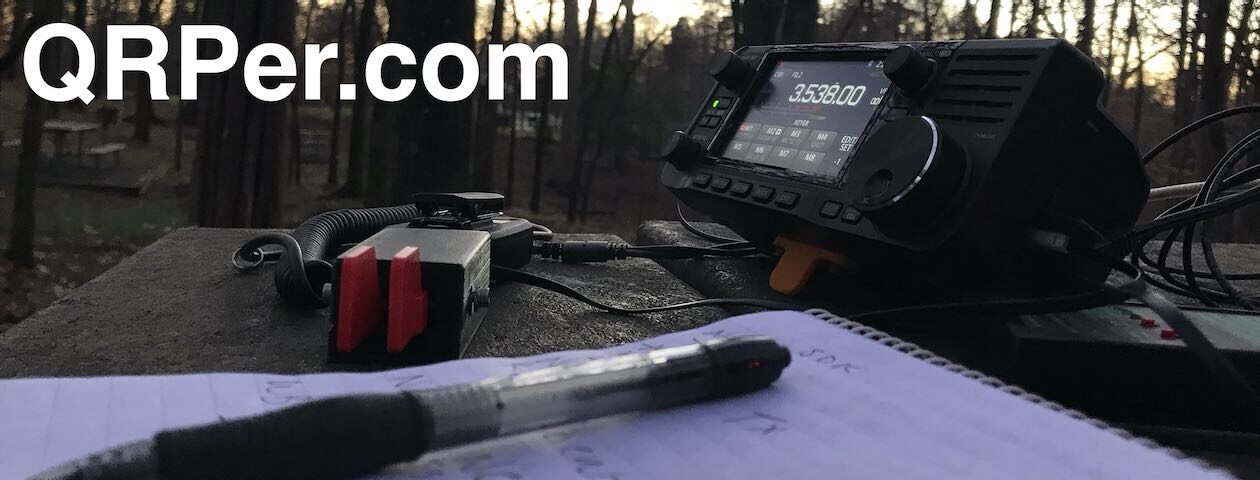by Eric, WD8RIF
I recently decided that I would operate portable during the upcoming ARRL 10 Meter Contest and would combine this operation with a pair of Parks on the Air (POTA) activations, one on the Saturday of the contest and one on Sunday. While putting together my field station for this, I realized I wanted to see how lossy my RG-58 and RG-316 feedline cables were on 10m. Yes, I could have resorted to online charts of feedline losses, and I know that the RG-316 is lossier than the RG-58, but I thought it would be fun and more enlightening to make actual measurements, to empirically determine the losses in my particular coaxial cables.
The two coaxial cables in question are both 25′ in length and both are equipped with BNC male connectors on each end. The RG-58 cable is a high-quality cable that was originally manufactured to be a 10Base2 ethernet cable, but it’s probably now over twenty years old. The RG-316 cable was recently purchased from Tufteln (link) and includes an RF choke near one end.
To make my measurements, I used my Elecraft KX2 (link) to generate RF into an Elecraft DL1 dummy load with RF detector (link), using a digital multimeter to measure the voltage at the DL1’s measurement points. I used the formula that came with my DL1 assembly instructions to calculate the measured wattage:
P = (((V x 1.414) + 0.15))^2)/50
I made measurements in the CW portion of the 10, 15, 20, 40, and 80m bands, with the KX2 set at 5 Watts output.
My first set of measurements was made with the DL1 connected directly to the KX2’s antenna jack using a BNC union:
| Direct (no feedline) | ||
| Band | Volts | Watts |
| 10 | 11.62 | 5.498 |
| 15 | 11.59 | 5.470 |
| 20 | 11.61 | 5.489 |
| 40 | 11.63 | 5.508 |
| 80 | 11.63 | 5.508 |
My immediate observation was that the KX2 appears to be generating more than 5w when it is set to be producing 5w but also that the KX2 output is essentially same from 10m through 80m.
My second set of measurements was made with the DL1 connected to the KX2 through the RG-58 cable:
| Direct | RG-58 | |
| Band | Watts | Watts |
| 10 | 5.498 | 4.809 |
| 15 | 5.470 | 4.844 |
| 20 | 5.489 | 5.004 |
| 40 | 5.508 | 5.184 |
| 80 | 5.508 | 5.276 |
My third set of measurements was made with the DL1 connected to the KX2 through the RG-316 cable:
| Direct | RG-316 | |
| Band | Watts | Watts |
| 10 | 5.498 | 4.190 |
| 15 | 5.470 | 4.322 |
| 20 | 5.489 | 4.507 |
| 40 | 5.508 | 4.774 |
| 80 | 5.508 | 4.959 |
I was pleased to see to see that both the RG-58 and RG-316 behaved as I expected them to: the loss increased with increasing frequency.
Using the magic of MS-Excel, I created a table of Loss in Watts for both cables, relative to direct connection and to each other:
| Direct | Difference (Loss) (Watts) | |||
| Band | Watts | RG-58 vs direct |
RG-316 vs direct |
RG-316 vs RG-58 |
| 10 | 5.498 | 0.690 | 1.309 | 0.619 |
| 15 | 5.470 | 0.626 | 1.148 | 0.522 |
| 20 | 5.489 | 0.485 | 0.982 | 0.497 |
| 40 | 5.508 | 0.324 | 0.734 | 0.410 |
| 80 | 5.508 | 0.232 | 0.549 | 0.317 |
In looking at this table, it was immediately obvious that RG-316 is much lossier than the RG-58, particularly on 10m. By looking at the row for 10m, one can see that I am losing nearly 0.7 watts in the RG-58 but I am losing over 1.3 watts in the RG-316.
For completeness, I added columns for Loss in dB to the spreadsheet:
| Difference (Loss) (dB) | |||
| Band | RG-58 vs direct | RG-316 vs direct | RG-316 vs RG-58 |
| 10 | 0.582 | 1.180 | 0.598 |
| 15 | 0.528 | 1.023 | 0.495 |
| 20 | 0.402 | 0.856 | 0.454 |
| 40 | 0.263 | 0.621 | 0.358 |
| 80 | 0.187 | 0.456 | 0.269 |
This exercise showed me that for my upcoming ARRL 10 Meter Contest POTA outings, I would do best by connecting my antenna directly to my transceiver, if possible, without using either coaxial feedline. If conditions at the operating site require me to use feedline, I will chose the RG-58 over the RG-316.
The tables also tell me that RG-316 is pretty lossy regardless of the band; for my regular field operating, unless I’m planning to do bicycle- or pedestrian-portable operations where weight and bulk is a consideration, I’ll carry RG-58 instead of RG-316. (I purchased the RG-316 specifically for bicycle- and pedestrian-portable operations, and I plan to continue to use the RG-316 for those applications.)
At some point, I will repeat this exercise with RG-8X, a feedline that is very close in size to RG-58, is less lossy, but is also heavier and stiffer.









